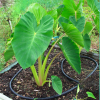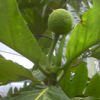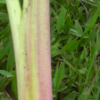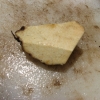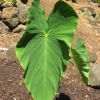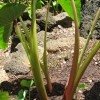Use As Food
Mainly as table taro. The taro has excellent quality as a table taro. The Mana and the Lauloa taros are used in preference to all others for making the Hawaiian pudding kūlolo, which is a combination of grated taro and coconut milk.
Distribution
Found extensively under upland, dryland culture (māla) in Kona, Puna, and Ka‘ū, Hawai‘i; does well under wetland (lo'i) culture on Kaua‘i.
General Characteristics
Medium in height, slender, erect, maturing within 7 to 12 months, producing two or three branches ; distinguished by pinkish- rose color of hā (Petiole).
Ha (Petiole)
50 to 85 cm. long, pink-rose colored when young, changing to yellow-green except near kōhina (base), with narrow, indistinct, light pinkish edge.
Lau or Lu'au(Leaf Blade)
30 to 50 cm. long, 20 to 30 cm. wide, 20 to 40 cm. from tip to base of sinus, arrow head shaped, vertical, firm-chartaceous (paper like), dark green or with bluish cast; piko pink or yellowish, the color extending into the main veins of the round leaf section (lobes); round leaf section (lobes) acute with deep lihi māwae (sinus).
'I'o kalo (Corm)
Flesh yellow with light yellowish fibers; skin yellow.
Pua (Flower)
Remarks
The orange-yellow flesh of the cooked taro is very attractive.

